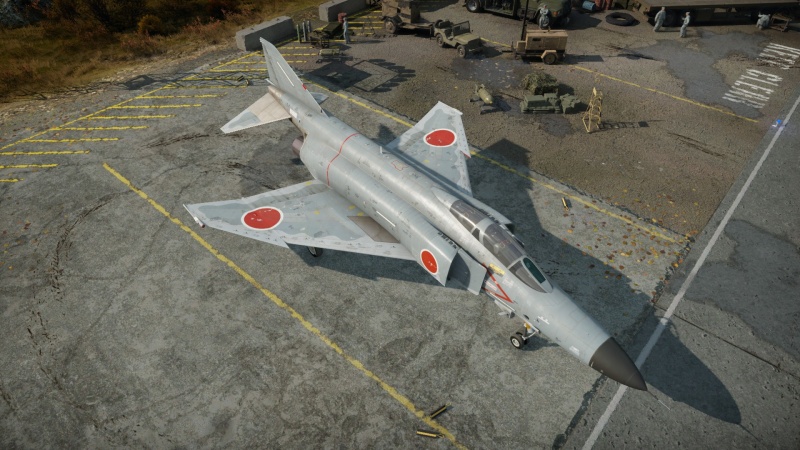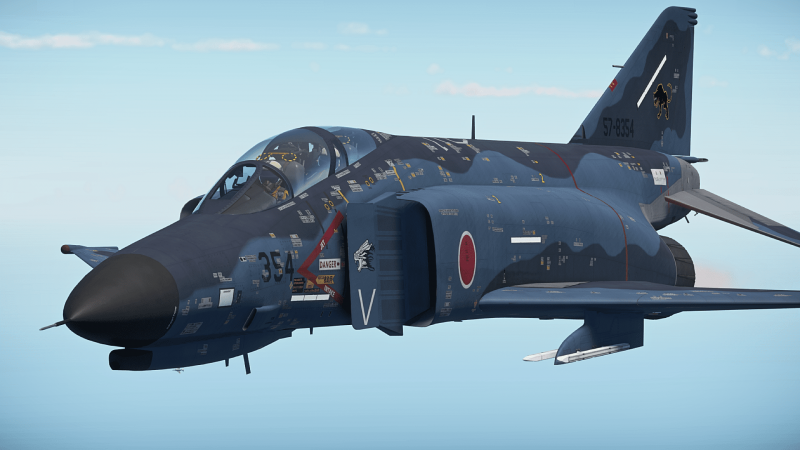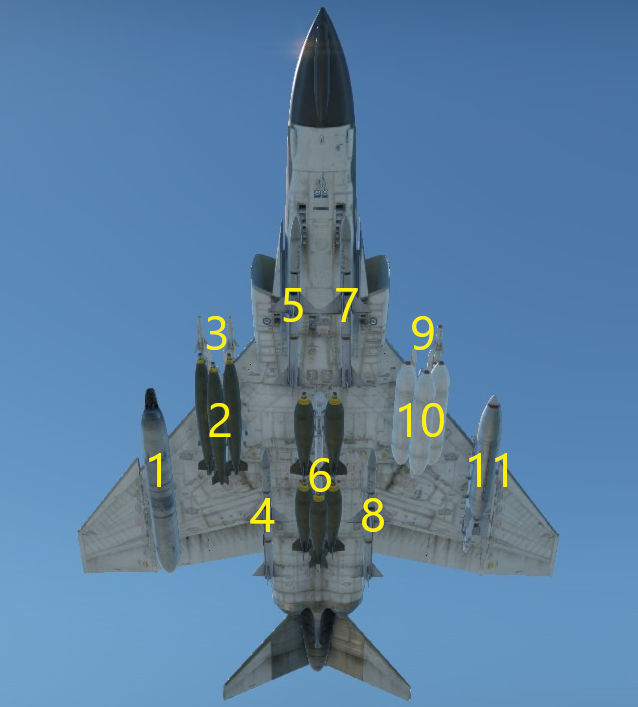F-4EJ Kai Phantom II
| This page is about the Japanese jet fighter F-4EJ Kai Phantom II. For other versions, see F-4 Phantom II (Family). |
Contents
Description
The F-4EJ Kai Phantom II (known as F-4EJ改) was one of the cornerstone of the JASDF based on previous F-4EJs manufactured in Japan; as the airframe and avionics started to become obsolete by early 1980s, MHI and JASDF planned for the upgrades for the fleet of Phantoms with new controls, navigation systems and pulse-doppler radar. After the budget was passed, 90 of these jets were then converted into F-4EJ Kai standards and served JASDF for the next 3 decades until their ultimate decommission in 2021 from ADTW of JASDF.
Introduced in Update "Direct Hit" as one of the earliest jets to receive PD radar in future updates, F-4EJ Kai introduced enhanced avionics for the already obsolete airframe of F-4EJ while retaining its combat capabilities against future jets or bombarding enemy ground target with high bomb payload. But be sure plan ahead for any assaults and avoid dogfights with other jets since hit-and-run greatly enhance the survivability of the jet.
General info
Flight performance
| Characteristics | Max Speed (km/h at 12,192 m) |
Max altitude (metres) |
Turn time (seconds) |
Rate of climb (metres/second) |
Take-off run (metres) | |||
|---|---|---|---|---|---|---|---|---|
| AB | RB | AB | RB | AB | RB | |||
| Stock | 2,255 | 2,221 | 16000 | 26.5 | 27.4 | 141.6 | 131.6 | 850 |
| Upgraded | 2,419 | 2,340 | 25.6 | 26.0 | 204.3 | 172.0 | ||
Details
| Features | |||||
|---|---|---|---|---|---|
| Combat flaps | Take-off flaps | Landing flaps | Air brakes | Arrestor gear | Drogue chute |
| X | ✓ | ✓ | ✓ | ✓ | ✓ |
| Limits | ||||||
|---|---|---|---|---|---|---|
| Wings (km/h) | Gear (km/h) | Flaps (km/h) | Max Static G | |||
| Combat | Take-off | Landing | + | - | ||
| 1458 | 463 | N/A | 580 | 463 | ~11 | ~4 |
| Optimal velocities (km/h) | |||
|---|---|---|---|
| Ailerons | Rudder | Elevators | Radiator |
| < 810 | < 750 | < 700 | N/A |
Engine performance
| Engine | Aircraft mass | |||||
|---|---|---|---|---|---|---|
| Engine name | Number | Basic mass | Wing loading (full fuel) | |||
| General Electric J79-GE-17 | 2 | 13,965 kg | 403 kg/m2 | |||
| Engine characteristics | Mass with fuel (no weapons load) | Max Takeoff Weight | ||||
| Weight (each) | Type | 9m fuel | 20m fuel | 30m fuel | ||
| 1,750 kg | Afterburning axial-flow turbojet | 15,724 kg | 17,787 kg | 19,829 kg | 24,000 kg | |
| Maximum engine thrust @ 0 m (RB/SB) | Thrust to weight ratio @ 0 m (WEP) | |||||
| Condition | 100% | WEP | 9m fuel | 20m fuel | 30m fuel | MTOW |
| Stationary | 5,200 kgf | 8,008 kgf | 1.02 | 0.90 | 0.81 | 0.67 |
| Optimal | 5,200 kgf (0 km/h) |
10,170 kgf (1,400 km/h) |
1.29 | 1.14 | 1.03 | 0.85 |
Survivability and armour
- 8.5 mm of Steel below the cockpit.
Modifications and economy
Armaments
| Ballistic Computer | ||||
|---|---|---|---|---|
| CCIP (Guns) | CCIP (Rockets) | CCIP (Bombs) | CCRP (Bombs) | Lead indicator |
| |
|
|
|
|
Offensive armament
The F-4EJ Kai Phantom II is armed with:
- A choice between two presets:
- 1 x 20 mm JM61A1 cannon, belly-mounted (640 rpg)
- 1 x 20 mm JM61A1 cannon + 90 x countermeasures
Suspended armament
The F-4EJ Kai Phantom II can be outfitted with the following ordnance:
| 1 | 2 | 3 | 4 | 5 | 6 | 7 | 8 | 9 | 10 | 11 | ||
|---|---|---|---|---|---|---|---|---|---|---|---|---|
| 20 mm GAU-4 cannons (1,200 rpg) | 1 | 1 | 1 | |||||||||
| 500 lb LDGP Mk 82 bombs | 6 | 3 | 6 | 3 | 6 | |||||||
| 500 lb Mk 82 Snakeye bombs | 6 | 3 | 6 | 3 | 6 | |||||||
| 750 lb M117 cone 45 bombs | 3 | 3 | 5 | 3 | 3 | |||||||
| FFAR Mighty Mouse rockets | 57 | 57 | 57 | 57 | 57 | |||||||
| Zuni Mk32 Mod 0 ATAP rockets | 12 | 12 | 12 | 12 | 12 | |||||||
| AIM-7E Sparrow missiles | 1* | 1* | 1* | 1* | ||||||||
| AIM-7F Sparrow missiles | 1* | 1* | 1* | 1* | ||||||||
| AIM-9L Sidewinder missiles | 2 | 2 | ||||||||||
| AIM-9P Sidewinder missiles | 1, 2 | 1, 2 | ||||||||||
| 600 gal drop tanks | 1 | |||||||||||
| Maximum permissible loadout weight: 7,400 kg Maximum permissible wing load: 3,000 kg Maximum permissible weight imbalance: 1,500 kg | ||||||||||||
| * AIM-7E and AIM-7F Sparrow missiles cannot be mixed, only one type may be equipped across hardpoints | ||||||||||||
| Default weapon presets | |
|---|---|
| |
Usage in battles
The EJ Kai is a Phantom through and through, it is best played utilising its strengths, primarily in its powerful radar and AIM-7Fs, the AIM-7Fs are excellent in "head ons" and the AIM-9Ls are excellent for picking up players who aren't paying attention, what the EJ Kai lacks in flight performance is easily made up for in its excellent missiles, as you'll find anyone who isn't glued to the deck is a free kill. The AIM-9L missiles are similarly powerful, with good flare resistance allowing you to equalise any engagement.
Pros and cons
Pros:
- Eased up modifications over the F-4EJ
- Comes with 2 x AIM-9Ps stock instead of 2 x AIM-9Bs
- 4 x AIM-9Ps is a tier I mod without the need of AIM-9Es
- A wide range of suspended armaments, suitable for any playstyle
- Powerful AIM-7F SARH missiles, with very long range, manoeuvres straight off the rails and have 25G of max overload
- Top-of-the-line AIM-9L missiles, having excellent manoeuvrability of 30G, long-range, great all-aspect tracking, and being pretty flare resistant when firing rear-aspect
- Can carry 8 missiles in total
- Deadly frontal armament with high burst mass
- Makes use of a ballistic computer to assist in the aim of cannons, rockets, and bombs against ground targets
- Large reserve of countermeasures
- AN/APG-66 radar - has diverse scan and tracking modes, very high resistance to notching and chaff, very long-range
Cons:
- Limited ammunition in the frontally-mounted cannon
- Lacks guided ordnance, limiting ground attack ability
- Terrible manoeuvrability along with mediocre acceleration and top speed, particularly compared to common opponents
- Doesn't have an Agile Eagle package like the F-4E and F-4F to increase manoeuvrability
History
Since the introduction of the Mitsubishi F-4EJ in 1968, it had been one of the cornerstones of the JASDF along with the F-104J and then later F-15J/DJ; but being a jet from the mid-1960s with inferior avionics and armaments to the latest Soviet jets also meant an extensive upgrade for the fleet of EJs was required. The plans for upgrading the 90 MHI-built F-4EJs which were still airworthy started in 1981 and the first retrofitted jet (07-8431) took to the skies in July 1984 and joined the JASDF in December. Upgrades included:
- Installation of J/AYK-1 guidance system for AShM and unguided bombs
- Replacing AN/APQ-120 with the latest AN/APG-66J with pulse-Doppler capabilities; J/AVQ-3 radar display and guidance system for SARH AAMs
- New J/ASN-4 digital INS navigation system
- New Kaiser Electronics HUD
- J/APR-6 RWR, AN/APX-76A IFF, and AN/ALQ-131 countermeasures
- HOTAS controls
- Lightning rods by the radome
- New fuel tanks
These features passed for the budgets of FY1987 and the upgrades for these jets finished by 1990.
By the time F-15J/DJs and F-2s joined the JASDF in larger quantities, F-4EJs (including the recon variant, RF-4EJ) were starting to retire. On 17 March, 2021, the very last 3 F-4EJ (Kai)s of the JASDF (17-8301[4038], 47-8336[M036] and 07-8431[M131]) retired from the Air Development and Test Wing (ADTW) in Gifu Airbase, Nagoya, bidding farewell of Phantoms in JASDF service. [1]
| 07-8431 (EJ Kai) and 17-8301 (the very first JASDF EJ) were also used for the sampling of the in-game representation of this jet as the developers and DMM announced for a trip to Gifu before their ultimate decommission.[2] |
Media
- Skins
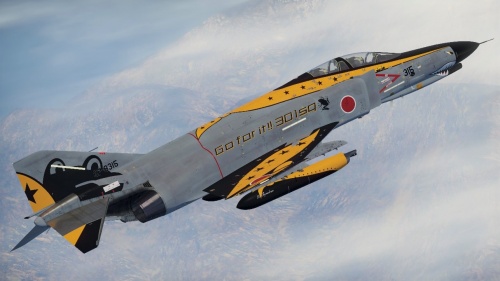
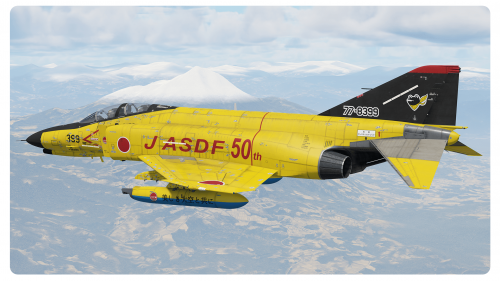
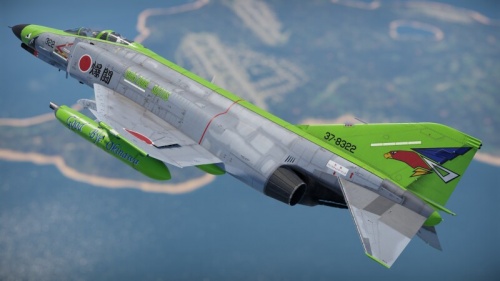
See also
- Related development
- Aircraft of comparable role, configuration and era
- Mikoyan-Gurevich MiG-21 (Family)
- SAAB J35D Draken
- Dassault Mirage IIIC
External links
| Japan jet aircraft | |
|---|---|
| IJNAS | |
| Experimental | Kikka |
| Reconnaissance | R2Y2 Kai V1 · R2Y2 Kai V2 · R2Y2 Kai V3 |
| IJAAS | |
| Fighters | Ki-200 |
| JASDF | |
| Fighters | F-86F-30 ▅ · F-86F-40 ▅ · F-86F-40 JASDF▅ |
| F-104J | |
| F-4EJ Phantom II · F-4EJ ADTW · F-4EJ Kai Phantom II | |
| F-15J · F-15J(M) | |
| F-16AJ | |
| F-1 | |
| Trainers | T-2 Early · T-2 |
| Foreign | |
| Thailand | ▄AV-8S · ▄F-5E FCU |



